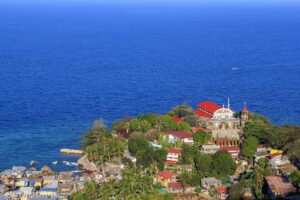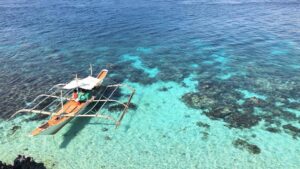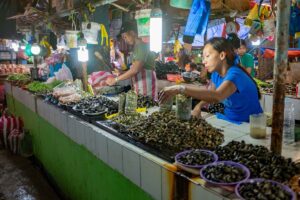
Coral Reefs in Palawan: Gateways to Underwater Worlds
Imagine this: Diving into crystal-clear water, you’re surrounded by a rainbow of colors and bizarre shapes. Clownfish peek from fluffy anemones, moray eels lurk in caves, and schools of impossibly bright fish shimmer past structures resembling antlers, brains, and even clusters of bubbles. Welcome to the world of coral reefs in Palawan – living sculptures more intricate than any art gallery. Let’s explore these underwater cities and the incredible creatures that build them!
What Makes Palawan’s Reefs Special?
Palawan’s location within the Coral Triangle means it boasts some of the world’s most biodiverse marine ecosystems. This biodiversity hotspot is home to thousands of fish species and countless other creatures, making coral reefs in Palawan a non-stop underwater wildlife spectacle! While corals might look like rocks, they’re actually colonies of tiny animals called polyps! Each type builds its own unique home, contributing to the reef’s complex structure and creating a haven for its inhabitants.
Types of Coral Reefs in Palawan
Get ready to add some new words to your vocabulary – coral reefs in Palawan have it all!
- Delicate Dancers: Look for swaying Gorgonian sea fans and long, graceful whip corals. These filter food from the currents, adding movement to the reef.
- Brain Teasers: Brain corals, with their maze-like patterns, are fascinating to examine up close. Some colonies can be hundreds of years old, offering a glimpse into the reef’s history.
- Bubble Wonders: Bubble corals look like clusters of grapes, each ‘grape’ able to inflate to catch sunlight for the coral’s food.
- Branching Beauties: Staghorn corals resemble deer antlers, growing rapidly and providing shelter for fish. Table corals create flat platforms, serving as rest stops for turtles and other creatures.
- Not-So-Friendly Fire: Despite the name, fire coral is a stinging relative of jellyfish. Its delicate beauty is best admired from a safe distance!
- The Soft Touch: Soft corals lack hard skeletons, instead resembling colorful, fleshy plants gently swaying in the water. Their flexibility allows them to thrive in areas with strong currents.
- Surprise Shapes: Mushroom corals look just like their land-based namesakes, adding a whimsical touch to the reef. Find them hiding in crevices or nestled between larger coral formations.
- Living Labyrinths: Massive porites corals can take centuries to reach their full size, creating intricate, fortress-like structures for a whole ecosystem of fish and invertebrates. Look carefully for tiny creatures like crabs hiding amongst the branches.
Beyond Just Beautiful: Diving Deeper into Palawan’s Reefs
Coral reefs in Palawan aren’t just a beautiful sight; they play a crucial role in the ocean’s health, the lives of people in Palawan, and even in your own life!
- Ocean Supermarkets: Reefs are the bustling heart of marine food chains, supporting everything from the tiny shrimp locals enjoy as a seafood delicacy to majestic manta rays.
- Coastal Protectors: Reefs act as natural breakwaters, buffering shorelines from storms and erosion, safeguarding Palawan’s stunning beaches and coastal communities.
- Economic Powerhouses: Healthy reefs attract scuba divers and snorkelers from around the globe and support local fishing communities, providing livelihoods and tourism income throughout Palawan.
- Medicine Cabinet of the Future: Reef creatures possess unique compounds with potential for new medicines and treatments, holding the key to future medical breakthroughs. Perhaps a coral-derived substance could one day cure a disease affecting you or your loved ones!
- Carbon Sinks: Believe it or not, some types of coral help reduce harmful carbon in the atmosphere, making them allies in the fight against climate change.
Threats and How You Can Help
Sadly, coral reefs in Palawan face threats like pollution, climate change-related coral bleaching, overfishing, and destructive fishing practices. Here’s how you can make a difference:
- Choose Eco-Conscious Operators: Support tour companies that prioritize reef protection and educate their guests, ensuring your tourism dollars help conservation efforts. Ask operators about their sustainability practices before booking.
- Spread the Word: The more people understand reefs, the more people will care. Share what you’ve learned with friends and family, inspiring others to become ocean protectors too.
- Reef-Safe Habits: Use reef-safe sunscreen, avoid touching corals while snorkeling, and pick up any litter you see on Palawan’s beaches.
- Everyday Actions Matter: Reducing plastic waste and making sustainable choices even at home helps protect Palawan’s reefs by minimizing pollution that can damage reefs even though they’re far away.
Island Hopping to Reef Wonders: Try Green Gecko!
Seeking an unforgettable way to see Palawan’s reefs while minimizing your environmental impact? Green Gecko Expeditions offers amazing 3-day boat trips between Coron and El Nido, with a focus on island hopping. Their responsibly-run tours often include snorkeling stops at vibrant reefs. Look for keywords like ‘Coron to El Nido boat tour’, ‘Philippines island hopping’, or ‘El Nido to Coron expedition’ to find the perfect trip.
Palawan’s Reefs: An Adventure Awaits
Whether you’re a seasoned diver or a snorkeling newbie, coral reefs in Palawan offer a glimpse into an extraordinary other world. From spotting clownfish playing hide-and-seek in anemones to marveling at schools of fish that outnumber any city crowd, each visit is a unique experience. As you marvel at their colors, shapes, and bustling life, you’ll understand why protecting these natural treasures is so important for generations to come, ensuring this underwater magic is there for your children and theirs.
Have you explored the coral reefs in Palawan? Share your favorite species in the comments!




